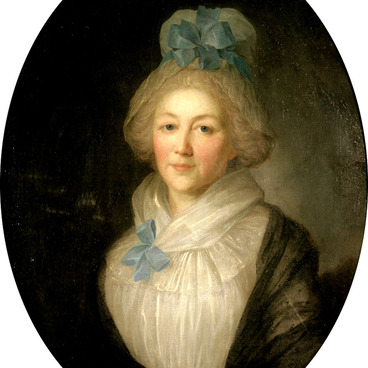Among the foreign painters who worked at the court of Catherine II, Johann Baptist Lampi deserves a special mention. He created one of the most famous ceremonial portraits of Her Majesty - Portrait of Empress Catherine II with the allegorical figures of the Fortress and Truth’ (1793). It is from this portrait, for which the empress personally posed, that various replicas were made. They came in different sizes and formats and were designed for different needs and occasions. Sometimes changing the composition and setting, the artists created a new and quite independent work.
The miniature portrait of Catherine the Great in an oval represents the Empress in ceremonial attire with ribbons of the Order, and the small imperial crown indicates the ceremonial primary source. Like in the large portrait, it depicts an ermine mantle over the shoulders, lace trimming of the dress, colored ribbons of orders, a diamond buckle, a crown, and a golden diadem. Such small, intimate cabinet-format portraits were intended for private use. They were ordered for gifts, presented as a sign of special favor or encouragement. The artist portrays the Empress in close-up, choosing the oval shape, typical for the miniature. This structure of the painting brought the “model to the viewer” as close as possible, neutralizing the usual distance for ceremonial portraits. The oval frame softened the solemn splendor and gave the portrait intimacy. The empress’s features seem to have a welcoming mood.
Thus, instead of the abstract majestic-ceremonial image of the empress-autocrat, a touching female portrait appeared, enchanting with both the grace of execution and the charm of the model. An exquisite color palette complements the beauty of this portrait. A whole series of gray shades stands out against a reddish neutral background: a powdered wig, a silvery brocade of a dress, a delicate neckline lace, and light fur of an ermine mantle. The accents were the order ribbons on the clothes of the empress and the solemn greenery of the laurel wreath.
The miniature portrait of Catherine the Great in an oval represents the Empress in ceremonial attire with ribbons of the Order, and the small imperial crown indicates the ceremonial primary source. Like in the large portrait, it depicts an ermine mantle over the shoulders, lace trimming of the dress, colored ribbons of orders, a diamond buckle, a crown, and a golden diadem. Such small, intimate cabinet-format portraits were intended for private use. They were ordered for gifts, presented as a sign of special favor or encouragement. The artist portrays the Empress in close-up, choosing the oval shape, typical for the miniature. This structure of the painting brought the “model to the viewer” as close as possible, neutralizing the usual distance for ceremonial portraits. The oval frame softened the solemn splendor and gave the portrait intimacy. The empress’s features seem to have a welcoming mood.
Thus, instead of the abstract majestic-ceremonial image of the empress-autocrat, a touching female portrait appeared, enchanting with both the grace of execution and the charm of the model. An exquisite color palette complements the beauty of this portrait. A whole series of gray shades stands out against a reddish neutral background: a powdered wig, a silvery brocade of a dress, a delicate neckline lace, and light fur of an ermine mantle. The accents were the order ribbons on the clothes of the empress and the solemn greenery of the laurel wreath.




